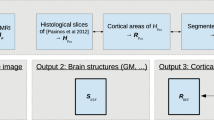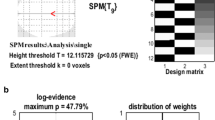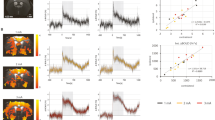Abstract
In the neuronal activation study of normal animals, precise anatomical correlation, preferentially to a detailed brain atlas, is required for the activation foci co-registration. To obtain precise regional correlation between H2 15O-PET images and the brain atlas, a method of stereotaxic image reorientation was applied to an activation study with vibrotactile stimulation. Cats anesthetized with halothane underwent repeated measurements of regional cerebral blood flow (rCBF) in the resting condition and during vibration of the right forepaw. The image set was adjusted three-dimensionally to the atlas. The postmortem brain was sectioned according to the atlas planes. The activated areas were determined by the stimulus-minus-resting subtraction images, and the areas were projected to the atlas. The PET images of the cat brain were compatible both to the postmortem brain slices and to the brain atlas. The activation foci obtained from the subtraction images corresponded to the area around the coronal sulcus, which is electrophysiologically known as the primary sensory area as described in the atlas. There were precise regional correlations between the PET image and anatomy in a PET activation study of the cat by means of stereotaxic image reorientation.
Similar content being viewed by others
References
Bohm C, Greitz T, Kingsley D, Berggren BM, Olsson L. Adjustable computerized stereotaxic brain atlas for transmission and emission tomography.AJNR 4:731–733, 1983.
Fox PT, Perlmutter JS, Raichle ME. A stereotactic method of anatomical localization for positron emission tomography.J Comput Assist Tomogr 9: 141–153, 1985.
Dann R, Hoford J, Kovacic S, Reivich M, Bajcsy R. Evaluation of elastic matching system for anatomic (CT, MR) and functional (PET) cerebral images.J Comput Assist Tomogr 13: 603–611, 1989.
Talairach J, Toumroux P. Co-planar stereotaxic atlas of the human brain. New York: Thieme, 1988.
Friston KJ, Frith CD, Liddle PF, Frackowiak RS. Comparing functional (PET) images: the assessment of significant change.J Cereb Blood Flow Metab 11: 690–699, 1991.
Pappata S, Fiorelli M, Rommel T, Hartmann A, Dettmers C, Yamaguchi T, et al. PET study of changes in local brain hemodynamics and oxygen metabolism after unilateral middle cerebral artery occlusion in baboons.J Cereb Blood Flow Metab 13: 416–424, 1993.
Heiss WD, Graf R, Wienhard K, Lottgen J, Saito R, Fujita T, et al. Dynamic penumbra demonstrated by sequential multitracer PET after middle cerebral artery occlusion in cats.J Cereb Blood Flow Metab 14: 892–902, 1994.
Reinoso-Suârez F. Topographischer Hirnatlas der Katze fur experimental-physiologische Untersuchungen. Darmstadt: E Merck AG, 1961.
Watanabe M, Uchida H, Okada H, Shimizu K, Satoh N, Yoshikawa E, et al. A high resolution PET for animal studies.IEEE Trans Med Imag 11: 577–580, 1992.
Iida H, Kanno I, Miura S, Murakami M, Takahashi K, Uemura K. Error analysis of a quantitative cerebral blood flow measurement using H2(15)O autoradiography and positron emission tomography, with respect to the dispersion of the input function.J Cereb Blood Flow Metab 6: 536–545, 1986.
Herscovitch P, Markham J, Raichle ME. Brain blood flow measured with intravenous H2(15)O. I. Theory and error analysis.J Nucl Med 24: 782–789, 1983.
Raichle ME, Martin WR, Herscovitch P, Mintun MA, Markham J. Brain blood flow measured with intravenous H2(15)O. II. Implementation and validation.J Nucl Med 24: 790–798, 1983.
Herscovitch P, Raichle ME. What is the correct value for the brain—blood partition coefficient for water?J Cereb Blood Flow Metab 5: 65–69, 1985.
Senda M, Kanno I, Yonekura Y, Fujita H, Ishii K, Lyshkow H, et al. Comparison of anatomical standardization methods regarding the sensorimotor foci localization and betweensubject variation in H2(15)O PET activation, a three-center collaboration study.Ann Nucl Med 8: 201–207, 1994.
Klüver H, Barrera E. A method for the combined staining of cells and fibers in the nervous system.J Neuropath Exp Neurol 12: 40, 1953.
Ogawa M, Magata Y, Ouchi Y, Fukuyama H, Yamauchi H, Kimura J, et al. Scopolamine abolishes cerebral blood flow response to somatosensory stimulation in anesthetized cats: PET study.Brain Res 650: 249–252, 1994.
Iwamura Y, Tanaka M. Functional organization of receptive fields in the cat somatosensory cortex. I: Integration within the coronal region.Brain Res 151: 49–60, 1978.
Matsumoto N, Sato T, Yahata F, Suzuki TA. Physiological properties of tooth pulp-driven neurons in the first somatosensory cortex (SI) of the cat.Pain 31: 249–262, 1987.
Heiss WD, Graf R, Lottgen J, Ohta K, Fujita T, Wagner R, et al. Repeat positron emission tomographic studies in transient middle cerebral artery occlusion in cats: residual perfusion and efficacy of postischemic reperfusion.J Cereb Blood Flow Metab 17: 388–400, 1997.
Fox PT, Burton H, Raichle ME. Mapping human somatosensory cortex with positron emission tomography.J Neurosurg 67: 34–43, 1987.
Meyer E, Ferguson SS, Zatorre RJ, Alivisatos B. Marrett S, Evans AC, et al. Attention modulates somatosensory cerebral blood flow response to vibrotactile stimulation as measured by positron emission tomography.Ann Neurol 29: 440–443, 1991.
Fox PT, Raichle ME. Focal physiological uncoupling of cerebral blood flow and oxidative metabolism during somatosensory stimulation in human subjects.Proc Natl Acad Sci USA 83:1140–1144, 1986.
Author information
Authors and Affiliations
Corresponding author
Rights and permissions
About this article
Cite this article
Sakiyama, Y., Toyama, H., Oda, K. et al. A stereotaxic method of anatomical localization by means of H2 15O positron emission tomography applicable to the brain activation study in cats: Registration of images of cerebral blood flow to brain atlas. Ann Nucl Med 11, 315–319 (1997). https://doi.org/10.1007/BF03165299
Received:
Accepted:
Issue Date:
DOI: https://doi.org/10.1007/BF03165299




